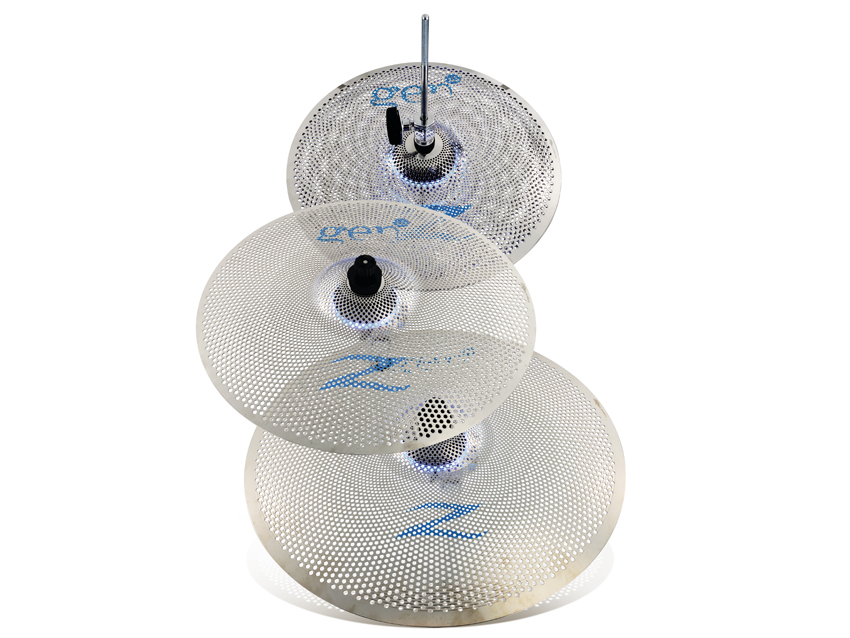MusicRadar Verdict
It's not the ideal bedroom solution (the cymbals are louder than pads), but for a lot of applications where current electronics are employed the Gen16 AE System represents the beginning of an exciting new chapter.
Pros
- +
Great range of 'proper' acoustic cymbal sounds. Excellent feel and dynamics. Potentially revolutionary technology.
Cons
- -
Not as quiet for bedroom use as regular pads.
MusicRadar's got your back
The nearly 400-year-old cymbal company might produce consistently impressive traditional instruments, but electronics? Who'd have thought?
But here are Zildjian's Gen16 AE Acoustic Electric cymbals in all their shiny glory...
Build
The Gen16 AE cymbal system does not rely on the usual triggering arrangement to create its sounds. Although it consists of a silver box into which 'cymbals' are plugged, these are not simply glorified switches.
"This is truly exciting stuff, so innovative that it's hard to know exactly how it's going to fit into our music-making lives."
Rather, the holey silver 'colander-esque' AE cymbals are 'real' cymbals, beneath which sits a dome-shaped dual microphone, which picks up the sound of the instrument and delivers it to the AE Digital Cymbal Processor.
Therein some clever digital signal processing shapes the sound that's delivered to the outputs of the little silver box. Think of it like an electric guitar - the pickup 'hears' the string vibrate, this energy is converted to an electrical signal which, if sent to a DSP device like a Line6 Filter Modeller, can make the guitar sound like a Moog synth, simply by shaping the waveform coming in.
It's important not to think of the AE system as a traditional electronic percussion device that works by sensing a physical touch and generating a tone in response, where literally ANY sound can be triggered - 808 bass drum, sampled laugh, acoustic snare emulation.
With the AE, it's all about offering 'real' acoustic tone in an electronic package that can be used for recording or live performance.
The most comprehensive Gen-16 package is the AE368, comprising 13-inch hi-hats, 16 and 18-inch crash and ride, the AE Digital Cymbal Processor plus mounting bracket and cabling. Other packages are available, as are individual cymbals.
The cymbals, as alluded to above, are pretty much the real deal, made from a special nickel-plated alloy, but much quieter than normal cymbals. These sit over the dual-mic pickups, which fit in the palm and appear pretty sturdy, with a rubberised top section and single mini-jack output.
The pickups send a signal to the compact DCP module, which has inputs for hi-hat, ride and three cymbals. It's a simple device in terms of controls - each input has a choice of 20 preset sounds, accessed by an up/down selector switch, Pan and Volume control.
The four pots to the right of the unit are 'global' controls for master volume, a mix pot (you can input a drum module to the DCP and this control allows you to blend drum module and Gen16 output), reverb and headphone volume.
The rear of the unit houses left/right outputs, the 'drums input' for an external brain, five mini-jack inputs for cymbals, a USB connection to allow firmware updates and Aux In for iPod etc.
Hands On
You can't approach the Gen16 system the same as any other e-percussion module. There's no great variety of classic electronic noises or ethnic instruments to choose from and no great scope for editing.
But because this is not a trigger-based set-up, there is a good selection of 'proper' acoustic cymbal sounds that respond very much like regular instruments, since that's pretty much what's creating them.
The technology behind the AE System largely eliminates concerns about dynamics and feel, because you're using an instrument and a mic as the building blocks from which the DSP in the Digital Cymbal Processor does its work.
This is truly exciting stuff, so innovative that it's hard to know exactly how it's going to fit into our music-making lives. Will it replace standard cymbals in acoustic set-ups on stage? Will it be the perfect rehearsal tool? Will studio drummers switch to the AE system exclusively? Who knows - probably a bit of all that, and more.
With its latest free update, Ableton has finally turned Note into the app I always wanted it to be
Technically capable, but struggle to make your tunes sound musical? 5 simple music theory hacks to make your tracks stand out
"Despite its size, it delivers impressive audio quality and premium functions as well as featuring a good selection of inspired sounds": Roland GO:Piano 88PX review










